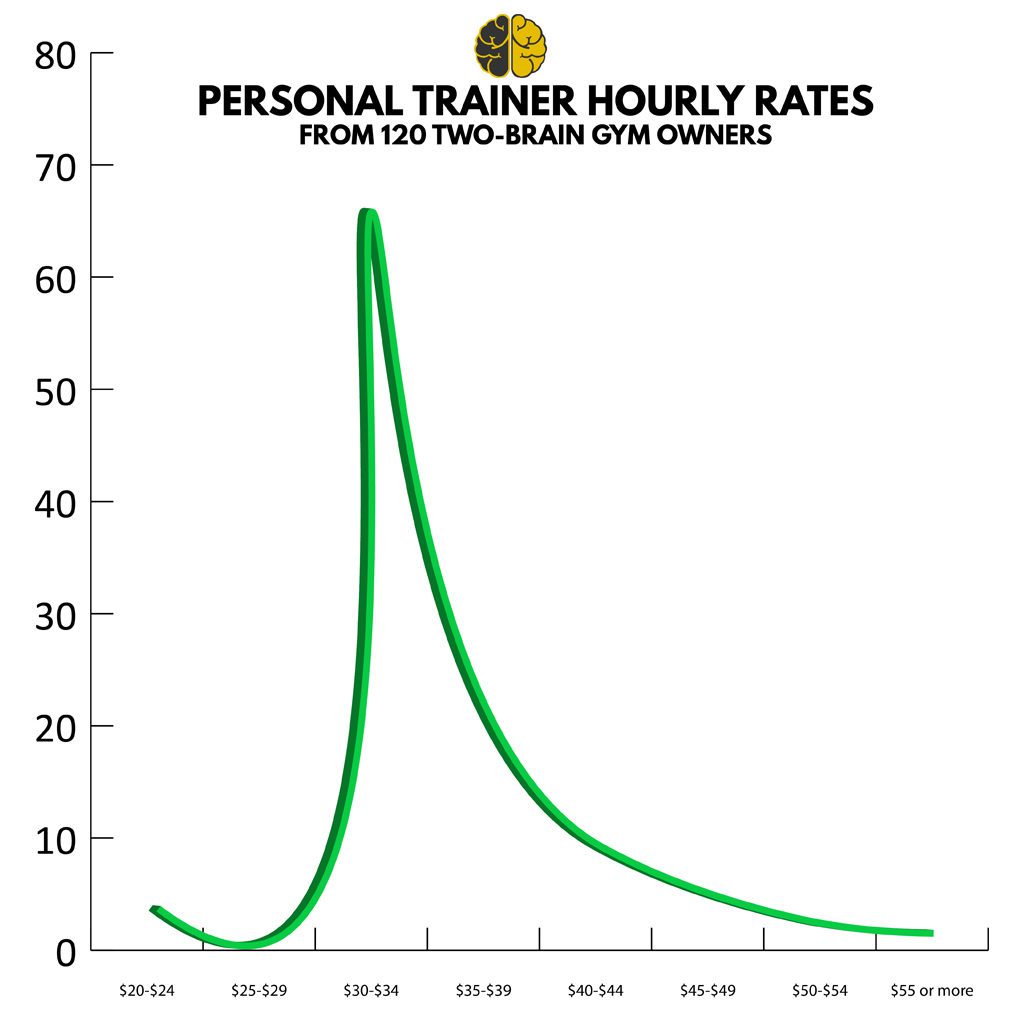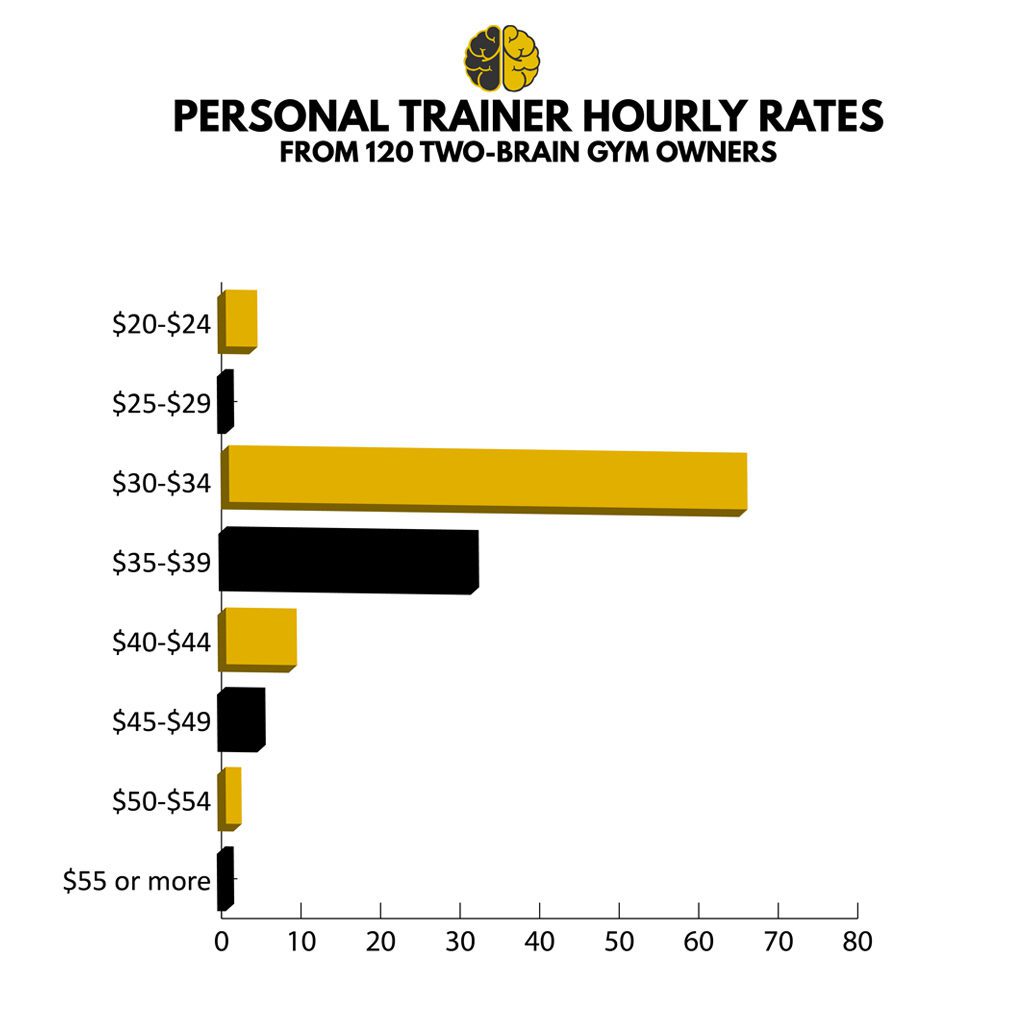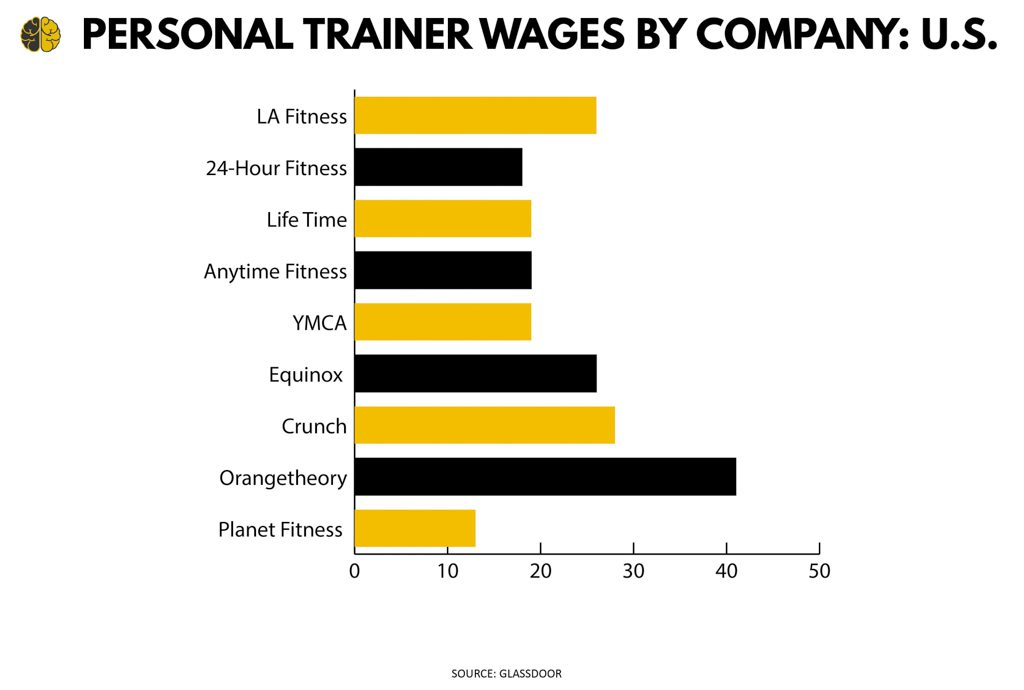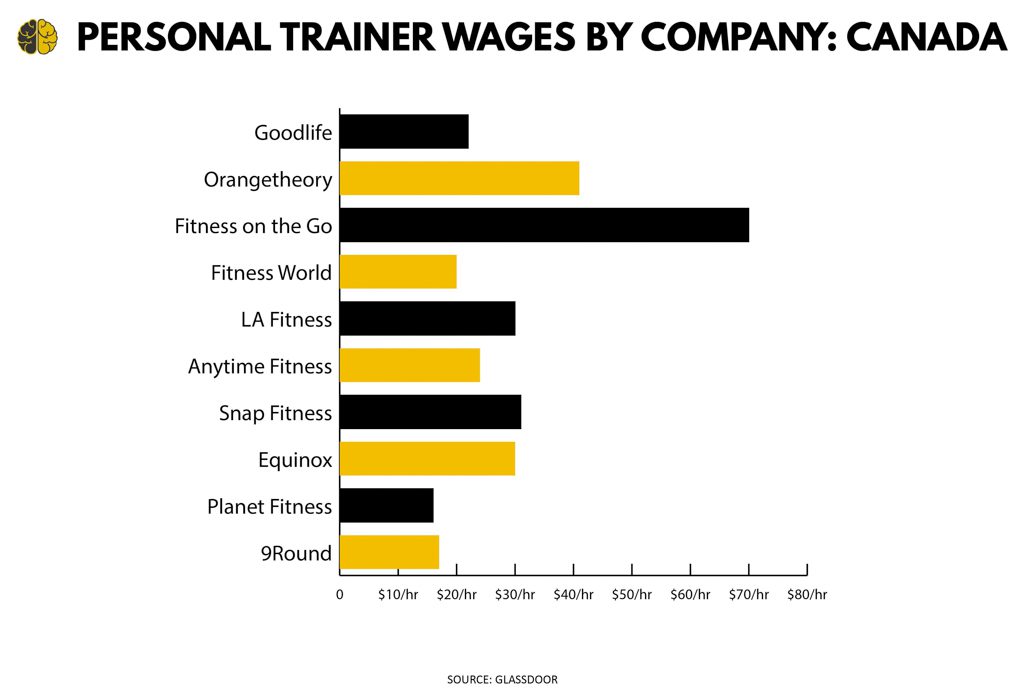If you’re considering a career in fitness, you’re right to ask a key question: How much does a personal trainer make?
Sure, you love health and fitness, and helping clients achieve their goals in a one-on-one setting has you jumping out of bed at 4:30 a.m. But you still need to make a living and pay your bills. If you don’t, you’ll get stressed and overworked, and you’ll lose your passion for coaching.
This happens too often in the fitness industry.
Below, we’ll tell you how coaches are paid. We’ll also tell you exactly how much personal trainers are paid. Then we’ll go over highs, lows and medians, as well as hourly rates from employers.
Even better, we’ll tell you where you can make the most money, as well as how you can increase your income and create a fulfilling, sustainable career.

How Does a Personal Trainer Get Paid?
If we’re asking how much does a personal trainer make, we need to understand the various pay structures in the fitness industry.
Here are five common ways personal trainers get paid.
1. General Hourly Wage (Plus Bonuses in Some Cases)
In this scenario, a trainer is paid a wage—usually a low wage—as a W2 employee who does personal training and perhaps other duties, such as attending a front desk, orienting clients to the facility, doing maintenance and so on.
Bonuses are common in this scenario—for membership, package and retail sales—but some gyms just pay a low hourly wage. If you’re looking to create a career in fitness, you should avoid the gyms that just play a flat rate with no opportunity to make more.
Other gyms will pay a minimum hourly wage for non-training hours but a different wage for personal training. The training rates often vary according to trainer qualifications, experience and volume.
Pro: The trainer is guaranteed an hourly wage and can sometimes make more through bonuses or commissions.
Con: The hourly wage is generally low—often minimum wage—and trainers must be good at selling and reselling packages.
Resource: “Working at Equinox: ‘It’s Very Hunger Games’”
Key info from the article: “Upon hiring, Equinox trainers begin a process called ‘ramping’: roughly 15 to 20 hours a week putting away weights on the gym floor, plus some additional hours of educational sessions, all paid at or slightly above minimum wage. During those floor shifts, trainers are expected to pitch their services to Equinox members working out in the gym. As they start accumulating clients, trainers can convert floor hours into better-compensated training sessions — $26 an hour for beginner trainers and as much as $62 per session for more experienced employees.”
2. Flat Rate Per Session
This common method is straightforward: A business pays a staff or 1099 contract trainer a flat rate for each session he or she coaches. This coach would just do training and not other gym tasks unless they were specified in the contract.
What’s hidden in this method of payment is the fact that the exact time to coach a session is in addition to the time spent preparing for the session or corresponding with clients outside sessions. So if a trainer is paid $40 for a 60-minute session, you can’t just say that personal trainer “makes $40 an hour.”
How much time does a trainer have to spend preparing for a session? It varies greatly and is influenced by the trainer’s skill, experience and systems. Some experienced, very organized trainers with huge workout libraries can create a three-session weekly training plan for a long-term client in five minutes. An inexperienced trainer working with a brand new client might take an hour or more to create that same plan.
In some cases, trainers are also responsible for admin tasks such as booking and billing, so that time should be considered as well.
When reviewing flat-rate data, be aware that the rates include all tasks associated with delivering a session—not just coaching a client during the session.
Pro: Trainers can earn more than minimum wage.
Con: Trainers generally have to find their own clients and must spend time doing related tasks outside the actual coaching session.

3. Space Rental or Percentage of Revenue
“Renting a chair” is common in the salon industry, and some gyms will use a similar system: They’ll allow trainers to operate their businesses inside the facility for a flat “rental fee” or perhaps for a percentage of revenue. Each option has advantages.
The flat rate is obviously good for trainers who have a ton of clients and don’t want to give up more and more money as they grow. The flat rate also guarantees the gym owner a set income even if the trainer doesn’t see a lot of clients.
Percentages can ensure a trainer doesn’t pay for space that isn’t used, and the gym owner benefits as the trainer’s income increases. This can help trainers who are just starting out and don’t want to pay a flat rate to serve just a few clients.
However, at a certain point a very successful trainer will usually calculate the amount of cash going to the gym owner and figure out if it’s too much. This can be a smart business move or a deadly trap: Some trainers think “the owner gets too much for too little” but forget to consider the real cost of running a facility. This cost can be extreme.
When running the numbers yourself, keep in mind that the gym owner provides space, equipment, utilities, insurance, cleaning, maintenance, bathrooms and showers, towel service, and more. Costs add up fast.
Pro: Rent or percentages can be negotiated to create the best situation for everyone involved.
Con: If circumstances change significantly before contracts expire, hard feelings and disagreements are common.
4. Complete Independence
Trainers who want to keep 100 percent of revenue can find ways to do it, but they’ll have to absorb some costs as sole proprietors. A price must be paid if you want to be the boss.
For example, you’ll need some equipment. That can be expensive. But you really don’t need a lot gear to be an effective coach. Many trainers spend far too much on things they never use. You only need enough gear to help your clients get fit. Check out a simple but very effective gear package here:
You’ll also need insurance, a website, a marketing plan and so on. You might also need coaching and billing software (check out our definitive review here).
The other requirement: space to train. You can use a park, a garage or even a client’s home. Just keep in mind that each has an associated cost. Training in parks usually requires a civic permit; a garage requires utilities, property taxes and maintenance; and a client’s home requires travel (time as well as transportation expenses).
Make no mistake: In this scenario, you are running a small business, so coaching is just one of many roles you’ll take on.
Pro: You are your own boss.
Con: You must cover all expenses, and your actual training time will be reduced because you must dedicate time to running the business.
5. The 4/9ths Model
While this Two-Brain Business model could be included in Section 3 above, it has some features that separate it from the simple percentage-of-revenue model.
In the 4/9ths Model—common in Two-Brain Business gyms around the world—a trainer is paid 44 percent of the training revenue, while the gym receives 55 percent. (Gym owners using this system generally dedicate 22 percent of total revenue to fixed costs and 33 percent to profit.)
The trainer is rewarded by generating value that allows him or her to charge premium rates and by booking lots of sessions. The gym benefits as well as successful trainers please clients and generate more revenue.
The key feature of the 4/9ths Model: This is an active partnership. The gym owner provides a captive audience of clients and works to promote the trainer’s services, offered in an insured, fully outfitted facility. Many owners also provide significant support and mentorship so the trainer succeeds. The trainer has access to the gym’s booking and billing software, marketing platforms, social media channels, facility and more.
A Career, Not Just a Job
In this arrangement, the gym provides so much value to the trainer that the 55-44 split works perfectly and both parties are happy.
Two-Brain gyms strive to provide great value to clients and create careers for coaches, so they generally don’t sell PT at rock-bottom rates. Instead, they find clients who will pay a premium for great service, which allows a coach to make a great living.
You can see what some Two-Brain gyms pay coaches in the graphics below. Of the 120 owners surveyed, 98 pay between $30 and $39 per session. You can compare that to rates at other facilities below.


Even better, gym owners can often provide opportunities for trainers to generate higher hourly rates through group specialty programs, small-group training, and additional coaching in areas such as nutrition, recovery and mindset. In some cases, these programs can allow a trainer to make excellent money.
Simple example: A coach runs a four-week, eight-session pull-up program priced at $125 per person. The gym owner helps the trainer promote the program, and 10 clients sign up.
10 x $125 = $1,250
$1,250 x .44 = $550
$550 / 8 = $68.75 per session
Don’t underestimate how important these high-value opportunities are. If you’re expecting to train clients 40 hours a week, you’ll probably burn out. A Two-Brain gym owner using the 4/9ths Model can provide lucrative alternatives to an endless string of back-to-back training sessions.

How Much Does a Personal Trainer Make: Industry Data
With the payment structures above in mind, it should be noted that personal trainers can really charge as much as clients are willing to pay. We aren’t talking about gouging. We’re talking about value and results.
For example, you’d probably agree that a personal trainer who helps a client accomplish a lifelong goal is underpaid at $20 an hour. Would you pay $50 an hour three times a week to avoid sickness—or would you pay more? Would you pay $200 an hour if you could dial up a trainer who would show up on demand at your office with all equipment, a post-workout meal, and an afternoon snack designed to help you meet your body-composition goals?
It’s not about price but value.
It’s a mistake to look at “what everyone else is doing” or “what the market will bear.” A better plan is to figure out the rate you need to charge to live the life you want, then create a service that justifies your rate. You might have to work hard to do it—but Two-Brain mentors help gym owners and trainers do this all the time. The result? Happy clients, happy gym owners and happy trainers.
Now, here’s some industry data.
Personal Trainer Wage Stats: United States
All funds in this section are in U.S. currency.
- Median: $62,377
- Bottom 10 percent of trainers: $30,866
- Bottom 25 percent of trainers: $45,010
- Top 25 percent of trainers: $76,636
- Top 10 percent of trainers: $89,618
(Source: Salary.com)
- Low: $28,000
- Average: $48,434
- High: $83,000
(Source: Glassdoor, based on 3,716 salaries)
Personal Trainer Wages by Company: U.S.
- LA Fitness: $26 per hour (938 reports)
- 24 Hour Fitness: $18 per hour (321 reports)
- Life Time: $37,051 (annual, 280 reports)
- Anytime Fitness: $19 per hour (276 reports)
- YMCA: $19 per hour (244 reports)
- Equinox: $26 per hour (232 reports)
- Crunch: $28 per hour (195 reports)
- Orangetheory: $41 per hour (119 reports)
- Planet Fitness: $13 per hour (113 reports)
(Source: Glassdoor)

- 2020 median pay: $40,510 per year, $19.48 per hour
- Number of jobs, 2019: 373,700
- Job outlook, 2019-2029: 15 percent (the field is expected to grow at a rate much faster than the 4 percent average rate for growth in all occupations)
- Employment change, 2019-2029: +57,600 jobs
(Source: U.S. Bureau of Labor Statistics)
Personal Trainer Compensation and Benefits: Equinox
- Tier 1: Approx. $35,000-$70,000
- Tier 2: Approx. $50,000-$92,000
- Tier 3: Approx. $62,000-$118,000
- Tier 4: Approx. $70,000-$130,000
- Tier 5: Approx. $88,000-$160,000
(Source: Careers.equinox.com; range reflects 95-160 sessions per month)
Resource: Reddit.com
Key info: “They SAY you can make 70k a year. Right now on a staff of 20 trainers I’d say MAYBE 3 of them are making that kind of money. The rest of us are struggling paycheck to paycheck and living at home. … Equinox is a company where you either do incredibly well or incredibly poor. … If you never hit 95+ sessions a month, you will never get off the floor and never hit bonus. There is a high turnover rate because not everyone is making the money they tell you they can be making.” —clydebarretto
Assorted Roles and Compensation: LA Fitness
- Personal trainer: $9-$31 ($16 average)
- Operations manager: $11-$25 ($16 average)
- Fitness instructor: $11-$37 ($19 average)
- Fitness trainer or aerobics instructor: $13-$40 (estimated)
Source: Payscale.com
Assorted Roles and Compensation: Planet Fitness
- Member service representative: $8-$12 ($10 average)
- Personal trainer: $9-$22 ($14 average)
- Fitness instructor: $9-$31 ($15 average)
Source: Payscale.com
Assorted Roles and Compensation: 24 Hour Fitness
- Personal trainer: $9-$34 ($16 average)
- Customer service representative: $9-$18 ($12 average)
- Fitness instructor: $12-$46 ($22 average)
Source: Payscale.com
Personal Trainer Wages: Canada
All funds in this section are in Canadian currency.
- Bottom 10 percent of trainers: $14.20
- Top 10 percent of trainers: $48.42
- Median: $21.46
Annual salary range: $30,000-$100,000
(Source: Payscale.com, based on 391 salary profiles)
- Average annual hourly rate: $26.17 (low: $20, high: $43.38)
- Average annual salary: $51,038 (low: $39,000, high: $84,581)
(Source: Talent.com, based on 288 salaries)
- Low: $30,000
- Average: $53,355
- High: $93,000
(Source: Glassdoor, based on 371 salaries)
Personal Trainer Wages by Company: Canada
- Goodlife: $22 per hour (179 reports; Payscale.com used 176 reports to come up with the same average, with a range from $9 to $46)
- Orangetheory: $41 per hour (27 reports)
- Fitness on the Go: $70 per hour (21 reports)
- Fitness World: $20 per hour (20 reports)
- LA Fitness: $30 per hour (17 reports)
- Anytime Fitness: $24 per hour (14 reports)
- Snap Fitness: $31 per hour (9 reports)
- Equinox: $30 per hour (12 reports)
- Planet Fitness: $16 per hour (6 reports)
- 9Round: $17 per hour (6 reports)
(Source: Glassdoor)


Free Business Plan for Personal Trainers
So how much does a personal trainer make?
The answer: It varies. A lot.
We’ve given you a wide overview of the industry, so you’re aware of different compensation structures and general wages and salaries in the gym business.
But we’ll give you something else: the ability to determine for yourself how much a personal trainer makes. With a little guidance, you can create the career you want. Maybe that career involves working the floor and hustling for clients at a large corporate gym.
But if you have other ideas about your career in fitness, Two-Brain can help.
First, use our client map to find an industry-leading gym near you. The owner will be eager to help you build a training practice that grows the gym and helps you create an ideal career. If you have big dreams, book a meeting with a Two-Brain gym owner.
We’ve also created a personal trainer business plan—and it’s free.
The plan has critical info on credentials, running a PT session, program building, program delivery, small-group coaching, scaling your business and adding new revenue streams. Read that document and put your plan together.
Now, when someone asks you “how much do personal trainers make,” you can answer with this:
“As much money as they want to make.”

